
Journey to Knighthood: The Hidden Steps of Becoming a Medieval Knight
The knight is arguably one of the most iconic figures of the Middle Ages. Knights were essentially mounted warriors, and in the hierarchy of medieval society, were considered to be part of the lower nobility. Nevertheless, knights could rise to the ranks of the higher nobility as well by acquiring land and becoming landlords.
While the role of the knight remained more or less the same throughout the Middle Ages, the perception of this social class evolved as time went by. It was only during the High Middle Ages (from around 1000 to 1300) that the image of the knight we are so familiar with today emerged. Additionally, what we know about the process of becoming a knight is drawn from this period.
Knights were originally professional cavalry warriors. While this may not be reflected in the English word, it is so in the French ‘chevalier’, and the Spanish ‘caballero’. These words trace their origin to the Latin ‘caballus’, which means ‘horse’. Incidentally, the English ‘knight’ (‘cniht’ in Old English) has West Germanic roots and is related to the Dutch and German ‘knecht’. Rather than denoting a cavalryman, however, these words mean ‘servant’, which is also a role performed by this social class, especially during their training.
The Knights of the Early Middle Ages and Medieval Period
During the Early Middle Ages, which lasted from around 500 to 1000, knights were considered to be violent brutes by most people. In exchange for their military service, the knights were given land or allowed to plunder the villages where they did battle. It was due to the latter that the knights of this period gained such infamy, as they looted, raped, and burned as they pleased.
Things began to change, however, during the 11 th century. Around the time of the Norman conquest of England in 1066, the knight began to take on the form we are familiar with today, i.e. heavily armored, mounted warrior from a noble background. In addition, it was also around this time that the famous chivalry, came into existence.
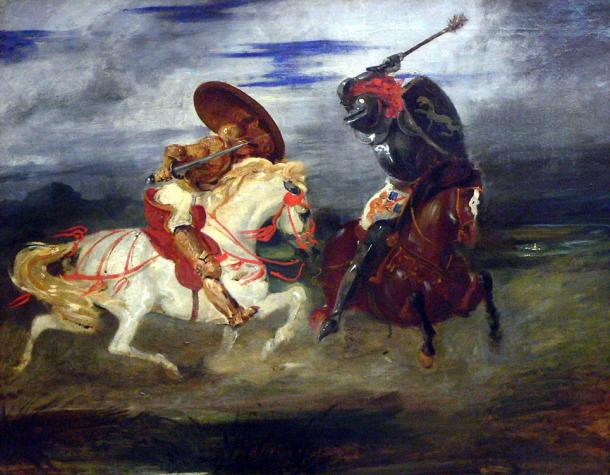
Before chivalry came into existence knights were considered violent brutes and were allowed to plunder. (Rama / Public Domain)
Basically, chivalry was the professional code of conduct that the Medieval knights adhered to. While the contents of this code differed from one commander to another, some of the most common elements include courage in battle and loyalty to one’s feudal or military superiors and comrades. These were values that were practical from a military point of view.
Nevertheless, the code of chivalry developed further to include such values as piety, generosity to the poor, and mercy for defeated foes. These were values endorsed by the Church and found their way into the romantic literature of that era, which was targeted at the young men who were training to be knights.
During the Early Medieval period, knights did not necessarily have to hail from the nobility. As long as a warrior could maintain the cost of his horse and arms, he could be a knight. During the succeeding High Medieval period, however, nobility and knighthood gradually merged, and knighthood became a hereditary privilege of the nobility. Therefore, the first step to becoming a knight during this period was to be born into a noble family.
- The Incredible History of Kolossi Castle - Won By Richard the Lionheart, Home to the Knights Templar, and Birthplace of the King of Wines
- Medieval Chivalry Wasn’t Just Knights and Valor
- Mystery of the Knights Templars: Protectors or Treasure Hunters on a Secret Mission?
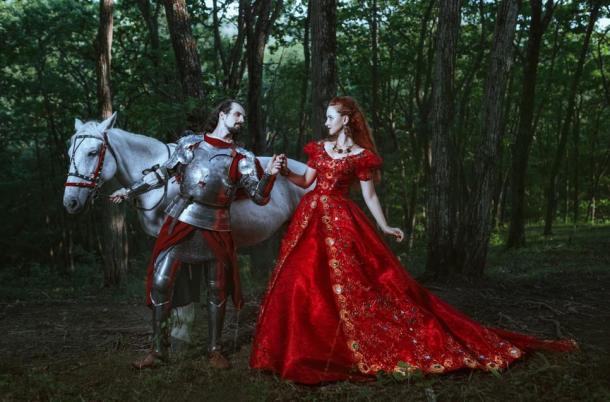
Knighthood changed with the code of chivalry and became a privilege of nobility. (grape_vein / Adobe)
In general, it was the sons of knights and lords who were eligible to become knights. Interestingly, while the majority of Medieval knights were men, there were exceptions to the rule. The Knights Templars and the Knights Hospitallers, the two foremost military orders during the Crusades, are said to have had warrior nuns in their ranks.
Training for Knighthood
The training to become a knight began as early as the age of seven. Up till then, the child selected to become a knight would be cared for by a foster mother in his father’s castle. Once the child was seven years old, he would be sent to the castle of another knight or lord. These were often relatives of the family, or lords to whom the boy’s father owed allegiance. The boy would serve as a page in the household of his lord. They would begin their service as assistants to squires and would be instructed in various aspects of knighthood.
Physical fitness, combat training, and care for a horse were essential aspects of a page’s training. Of course, these boys would not have fought with real weapons, but with wooden ones. In any case, these lessons were aimed at preparing them for life as a mounted warrior. Apart from that, pages were also instructed in falconry, hunting, dancing, and music, activities that befitted a nobleman. Moreover, the pages received lessons in religion, and were taught reading, writing, and arithmetic. The training of the pages shows that by this time, knights were expected to not only be warriors, but also cultured men of high society.
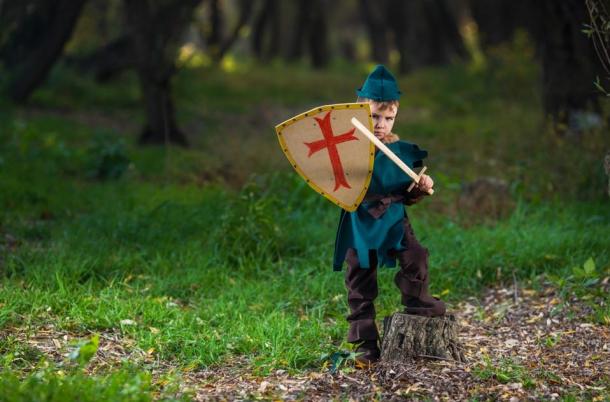
A page’s training on the way to knighthood included practicing with a wooden sword. (bokan / Adobe)
The training of a page continued until he reached puberty, about the age of 14. By this time, he was no longer considered to be a child, but a young man. A page would be formally promoted to a squire during a religious ceremony. A bishop or a priest would give a consecrated sword to the new squire, who would then swear to use it for honorable purposes or for the defense of the faith.
The training of a squire places much greater emphasis on martial prowess, as they are now mentally and physically prepared for it. This training included combat practice with real weapons, horsemanship, and skills that may come in handy when besieging another castle, including climbing, swimming, and athletics.
The word ‘squire’ is derived from the Old French ‘esquier’ and literally mean ‘shield carrier’. Indeed, one of the jobs of the Medieval squire was to maintain his lord’s weapons and armor, and to ensure that they were in good order. Other tasks performed by squires related to combat included tending to the horses, assisting his lord when he put on his armor, and accompanying his lord to the field of battle in times of war.
Martial training and service, however, was only one aspect of a squire’s life. The squire was not only a warrior-in-training, but also a nobleman, and therefore would have been taught to be one. The squire received lessons in music and dancing, court etiquette, and jousting. In addition, a squire was required to learn the code of chivalry, as well as the rules of heraldry.
Squires also learned to play some popular court games, such as chess, checkers, and backgammon. These games served not only as entertainment, but also as a means to develop strategic thinking.
On top of all this, a squire was also expected to serve in his master’s household, which would have prepared him to manage his own squires should he one day become a lord in his own right.
There were many tasks in a lord’s household that squires could perform. As mentioned earlier, one of the squire’s jobs was the care of his lord’s weapons and armor. This was an important job, as a knight’s equipment was expensive, and proper maintenance was necessary so that it could be used efficiently on the battlefield. Another important task was attending to the lord’s horses, as these mounts were as important to a knight as his armor and weapons.
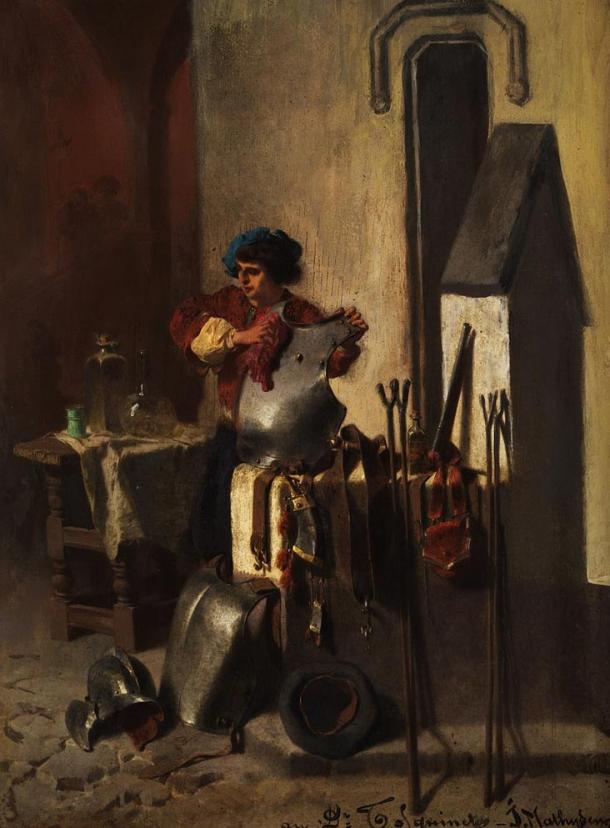
A squire cleaning armor, training for knighthood. (FA2010 / Public Domain)
Other chores were more domestic in nature, for instance, managing the wine cellar, carving meat at meals, waiting tables during banquets, assisting a lord during feasts and other ceremonies, and attending to the rooms of the castle. Through such acts of service, a squire was expected to cultivate humility, an important virtue in the code chivalry. Moreover, these tasks gave squires first-hand experience of navigating the intricacies of the Medieval upper class.
A knight-to-be often served as a squire for about seven years, until he reached the age of 21. In some cases, a squire may be made a knight at an earlier age, as a reward for displaying exceptional courage on the battlefield. There was no guarantee, however, that a squire would be made a knight. Before a squire could be made a knight, he had to acquire his own armor and weapons.
In some cases, the equipment may be given to a squire by his lord, looted on the battlefield, or won in a tournament. More often, however, these items had to be purchased. The quality of weapons and armor on sale varied, ranging from high quality ones custom-made by imperial workshops, and by famous German and Italian armorers, to second-hand and outdated pieces that could be readily bought at markets and shops. Be that as it may, even the equipment of lower quality cost a considerable amount of money, and not all squires could afford it.
Squires who could not meet these expenses, or were too old to be knighted, became known as ‘arma patrina’. Although these men had not undergone the ceremony of knighthood, they were allowed to carry a lance and a shield, which were privileges restricted to the knights.
The Knighthood Ceremony
The ceremony of knighthood usually took place during one of the great feasts, for instance Christmas or Easter. The ceremony may also be conducted on other special occasions, such as the wedding of a noble or monarch. The knighthood may be conferred onto a squire by a king, nobles, the clergy, or even the squire’s father (if he were a knight himself).
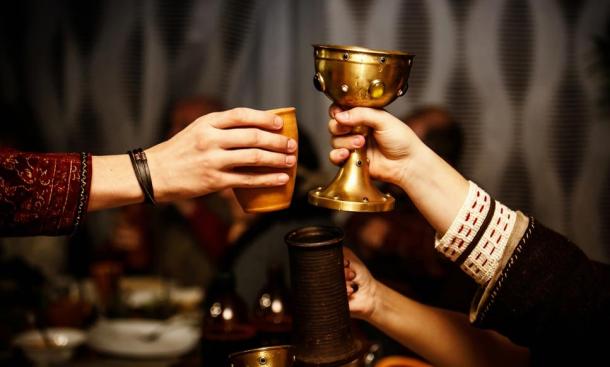
The ceremony of knighthood usually took place during a great feast. (9parusnikov / Adobe)
On the eve of the ceremony, the squire would take a ritual bath, and be dressed in a piece of white clothing, symbolizing purity. The squire wore over this a red robe, a sign of his nobility. The squire’s attire was completed by a pair of black shoes, symbolizing death. The squire would then spend the rest of the night in silent prayer in the chapel of the castle or a church.
The accolade (known also as dubbing or adoubement), took place on the following morning. This was the ceremony during which the knighthood was conferred onto the squire. The ceremony began with Mass, during which the priest would typically give a sermon about the duties and responsibilities of a knight.
A sword and shield which had been blessed by a priest would then be brought forward by the squire’s sponsor and given to the lord conducting the ceremony. After being presented to the lord, the squire took his vows, and swore allegiance to his lord.
The vows taken by the would-be knight reflected the code of chivalry. Among other things, he swore to be loyal to his lord, to be devoted to the Church, to defend the weak, to show generosity to the poor, and to always speak the truth. To break this oath would be to commit a crime against God, and any knight who did so would face divine retribution and eternal damnation.
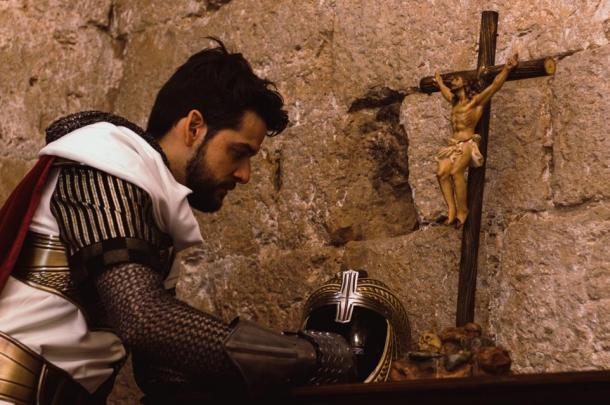
Vows taken in knighthood included devotion to the Church. (aitorserra / Adobe)
The final part of this solemn ceremony was the dubbing, after which the squire officially became a knight. The dubbing may be conducted by a fellow knight, a noble of higher rank, or even a king. With the exception of queens, the dubbing was rarely done by women.
The knight / lord who conducted the ceremony presented the squire with the sword and shield, after which he would strike him on the shoulder with the flat of the hand or the side of a sword, while saying ‘I dub thee Sir Knight’. The new knight was then dressed in his armor, had his sword girded, and given his spurs.
Once the formal ceremony was over the celebrations could begin. Music was played to greet the new knight and a feast awaited the attendants of the ceremony, where there would be eating, drinking, and dancing. On the following day, a tournament or martial games would be arranged, providing the new knight with the opportunity to show off his skills as a warrior.
- Call in the Cavalry: Famous Cavalries of the Ancient World
- The Sinister Roman Cavalry Helmet of the Ribchester Hoard
- Game of Thrones Creates a Romantic and Grotesque Pseudo-Medieval World, Revealing Modern Perceptions of the Past
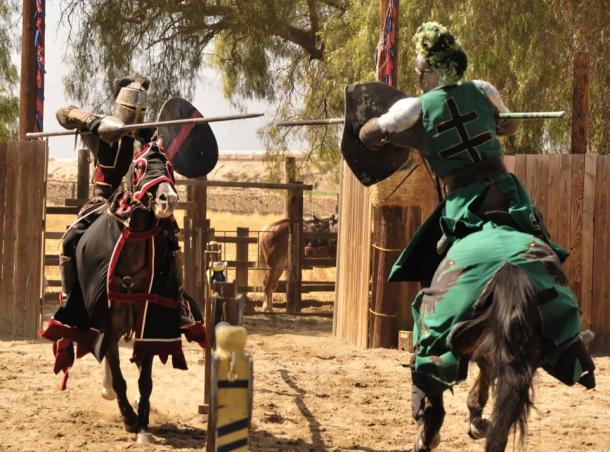
After the squire’s transition into knighthood there would be a tournament. (Clarence Alford / Adobe)
Lastly, a knight enjoyed many privileges, including the right to own land, to bear arms inside a church (since they were supposed to be the defender of God and Christianity), and to sit at the high table with other nobles and kings during banquets. It was the knight’s right to own land that formed the basis of Medieval feudalism.
A lord would grant a fief (normally a piece of land with peasants) to a knight in exchange for his military service. The enfeoffed knight (known also as vassal) served his lord for a period of time (normally 40 days a year) and could become a lord himself by enfeoffing other knights.
At times, a scutage (also called shield money), instead of military service, was paid to the lord. This form of payment became increasingly popular during the 12 th and 13 th centuries due to several factors including the expansion of the monetary economy in Europe, the increased reliance on mercenaries to fight wars, and the decline in the importance of cavalry.
Top image: Boy went through 14 years of training on the journey to knighthood. Source: Fxquadro / Adobe.
By Ḏḥwty
Updated on December 30, 2020.
References
Breiding, D. H. 2004. Arms and Armor—Common Misconceptions and Frequently Asked Questions. [Online] Available at: https://www.metmuseum.org/toah/hd/aams/hd_aams.htm
Freudenrich, C. 2008. How Knights Work: Becoming a Knight. [Online] Available at: https://history.howstuffworks.com/historical-figures/knight2.htm
Freudenrich, C. 2008. How Knights Work: The Knighting Ceremony. [Online] Available at: https://history.howstuffworks.com/historical-figures/knight3.htm
Gershon, L. 2019. Chivalry Was Established to Keep Thuggish, Medieval Knights in Check. [Online] Available at: https://www.history.com/news/chivalry-knights-middle-ages
HowStuffWorks.com. 2008. Knight: Training For Knighthood. [Online] Available at: https://history.howstuffworks.com/european-history/knights1.htm
Kalif Publishing. 2018. How a boy became a Knight in Medieval times. [Online] Available at: http://medievalcastles.stormthecastle.com/essays/how-a-boy-became-a-knight-in-medieval-times.htm
The Editors of Encyclopaedia Britannica. 1998. Knight service. [Online] Available at: https://www.britannica.com/topic/knight-service
The Editors of Encyclopaedia Britannica. 1998. Page. [Online] Available at: https://www.britannica.com/topic/page-rank
The Editors of Encyclopaedia Britannica. 2018. Knight. [Online] Available at: https://www.britannica.com/topic/knight-cavalryman
Velde, F. 2002. Knighthood and Chivalry. [Online] Available at: https://www.heraldica.org/topics/orders/knights.htm
www.medieval-life-and-times.info. 2019. Becoming a Knight. [Online] Available at: http://www.medieval-life-and-times.info/medieval-knights/becoming-a-knight.htm
www.medieval-life-and-times.info. 2019. Knighthood Ceremony. [Online] Available at: http://www.medieval-life-and-times.info/medieval-knights/knighthood-ceremony.htm
www.medieval-life-and-times.info. 2019. Medieval Knights. [Online] Available at: http://www.medieval-life-and-times.info/medieval-knights/
www.medieval-life-and-times.info. 2019. Medieval Squires. [Online] Available at: http://www.medieval-life-and-times.info/medieval-knights/medieval-squires.htm
















Comments
We need something like that today. Modern schooling is a dismal failure for boys, if not girls too, but seemingly by design.
Nobody gets paid to tell the truth.
Hi All,
This is an excellent article now I understand a few stories about The Knights I've been able to read so far and this Guide into how someone became A Knight is quite informative.
There are a 3 Subjects brought up in this here article but, I'll address them some other time and so Have a Happy New Year; Everybody an until Next Time Everyone, Goodbye!
I agree wholeheartedly
TO DHWTY
I noticed you author many articles here, and each one I've read so far is just great.
I really admire your effort and also ability to produce media this fast.
I hope you continue to write, and I'll be looking out for your first book :)
Best to you
Tim Miltz
Great article and so very informative!! :-)
Pages